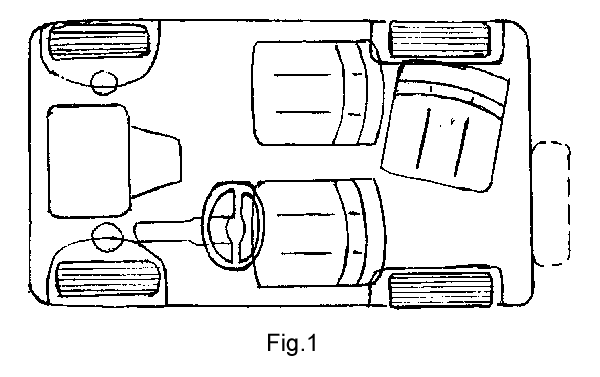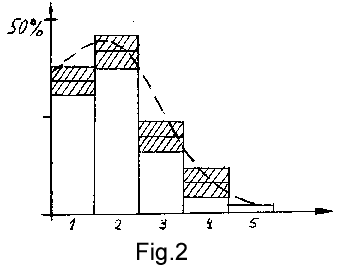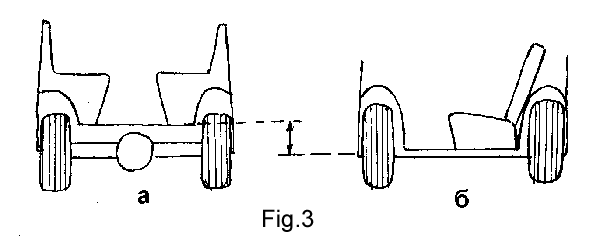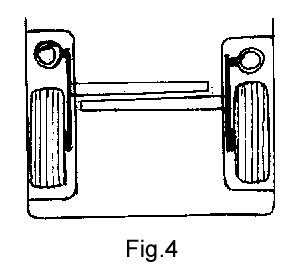
"TRICAR". A multipurpose car for
everyday use. The optimum scheme of disposition of seats.
| Russian |
https://shulga.tripod.com/tricar/E.htm
The car constructed under this scheme
will enable, in numerous cases, to do without constructive and functionally
redundant vehicles constructed along standard "2+2" scheme of seats disposition.
On the other hand, the proposed scheme enables to overcome functional insufficiency
of "half-size" 2 seat variants.
The car with a simplified body (a motorized
transport platform - the carriage) constructed along this scheme can replace,
with a number of basic operation advantages, such universal, operative
vehicle as a motorcycle with a sidecar.
ESSENCE OF THE PROPOSED SCHEME:
Two seats (the driver and one passenger)
are placed in the standard way - in parallel - in a line (in the interaxle
space).
The third seat is placed behind, crosswise,
flush with the first two (in the "hole" between rear wheels), with an exit
backward (through a back wall, a door, a niche). Fig.1.

EXPLANATORY NOTE. A justification of
rationality and uniqueness of the proposed scheme.
One of the principal requirements to
a modern car is a minimum dimension. Rather uneasy to enter the conventional
4-seat scheme in the frameworks of this requirement. It is necessary to economize
on the size of seats and free space for legs. Convenience of access to
seats is sacrificed. The second line, sometimes, is reduced till the "children"
sizes. Doors here are made narrower. Frequently, it is suggested to do without
these doors at all.
Thus as the statistician displays, the
private car transports, on the average, by different estimations 1,7-1,9 persons
for time. The averaged percent frequency of quantitative loading of the city
car is shown on fig.2.

In this connection, attempts to solve
the problem of creation of the optimum car on the basis of 2 seat schemes
seem to be quite natural. However, such decision results to that the car
in 20-25 %% cases appear functionally insufficient. Such insufficiency (expectation
of such insufficiency) does not allow to admit this variant as universal,
leaves its in the category exotic.
Adding of one more seat essentially
raises a degree of functional adequacy of the automobile. A 3-seat car is
already capable to satisfy the majority of trips - 90-95 %%. Practice displays
that number 3 is a certain "magic number" defining the maximum size of a
mobile, dynamical, easy and naturally casually ("spontaneously)" gathering
amount of people. Such amount of seats also should have a universal vehicle
of private use. 4 persons demand already qualitatively others - stronger
motives, occasions and principles for "collecting". The transport problem
here should be solved either in parallel or sequentially, or means of other
class.
Rationality (optimality) of the three-seat
car is defined also by fundamental geometrical feature of construction of
vehicles in general. The rectangular shape of a transport platform has the
greatest spreading. This circumstance is a consequence of property of rectangles
to be simply and compactly integrated with each other, and, in general, -
to fill-in densely a plane. For this reason, containers, furniture, locations,
structures, etc., etc., as a rule, have the rectangular shape in the plan.
Thus, the objective reality, basically,
gives us four sides - the generalized Doors for access into the internal
space of a transport platform. The front, on a course, side the Door, on
a number of the obvious reasons, appears rather inconvenient for arrangement
of entrance-exit. Three walls rest: two side and one back near every of
which one seat should be installed in the considered "minimum" case (two
in the standard way, and one behind, along the back)...
Thus it is possible to make a conclusion
in general the unique constructive functional rationality of 3 seat cars
with an exit backward.
As the pilot model it is possible to
consider automobiles, which rear seats, have transversal disposition (for
example, GAZ-69A). Their essential difference from proposed variant is
that seats are placed in the body under which bottom the rear axle with suspender
unit is situated (fig.3a).

Such arrangement results in a number
of essential objective and subjective inconveniences and deficiencies. The
barycentre of the machine lifts up, its dimensions are augmented. Access to
"uplifted" seats is inconvenient. It is uncomfortable to sit on them: there
are an increased range of the oscillations caused by irregularities of road,
and these seats appear less protected (out of overall dimensions).
A difference of the proposed decision
consists that the additional seat is suggested to be disposed flush with
the main ones (in the "hole" between rear wheels - fig. 3b). "Maximum board"
suspendsion of rear wheels, with "maximum bottom" constructional elements
is supposed.
As a first approximation here it is
suggested the independent suspension of rear wheels on the longitudinal
levers which are looking like plates situated on their edges (fig.4).

At one end of each such lever the dowel-shaft
for a wheel is placed. On the opposite end the vertical damper with a spring
fastens. All this is installed from the same side as the wheel, in wheel
niches. On the center, each lever rigidly fastens to a butt of its transverse
axles, rocking in the bottom plane. Torsion can be used as these axles.
They will undertake all loading or its part.
Forward drive is assumed to be the
most preferable here. The engine can be located in front or longitudinally,
on the center, between the driver and first passenger.
As a result of all these design solutions,
we obtain one more low-sited seat with convenient access. All machine turns
out compact and enough comfortable...
Rationality of the proposed Scheme is
also confirmed by its comparison to such known vehicle what is a motorcycle
with a sidecar. This machine also satisfies the requirements of constructive
simplicity, optimum amount of seats and easy access to them.
In this connection it is necessary
to tell, that production of an elementary, open, doorless body of Jeep
type (a transport platform-carriage), basically, not much more difficult
than production of a frame of heavy motorcycle and its sidecar (or a load
box of a tricycle). Such body-carriage is a set of panels with the
reinforcement ribs, strengthened by design structures (tubes, for example),
which form a frame as the whole, or its separate rudiments. The engine
and gear box in the considered three-seat variant basically (on power)
should be a similar class.
Thus, at expenditures of the comparable
order, we obtain a same universal, operative, mobile, small-size vehicle
as a motorcycle without its essential deficiencies...
Certainly, possibilities of realization
of the proposed seat scheme are not limited only to this variant. Generally,
the family of machines of different classes is planed. The transport platform-carriage
with the engine of low power, small wheels, cargo space can be covered with
a soft coverlet. "Jeep" with boards, without doors, with wind shield and
collapsible tent, the engine of the same power, that one of a heavy motorcycle.
Further, - the same as previous, with the elementary cabin and doors. And,
at last, the car with a high-grade cabin, a panoramic windshield, with movable
door glasses etc., etc. - up to the "lux" variant. .
* * *
At realization of the proposed seat
scheme the following design decisions seems to be expedient.
It is necessary to place the third
seat from the opposite side from the driver on the reasons of saving of
centering at free second seat.
A spare wheel is placed on the back
wall (door) on the outside of the seat (for the insurance at a possible
rear-end collision).
A fuel tank is installed from below,
within the framework of transversal "trapezoidal wave" of the bottoms under
seats of the driver and first passenger.
Passenger seats are demountable, for
placing of cargo.
It is necessary to provide attachment
nodes for various trailers and semitrailers, and, in particular, resting
on with the arc on the center of the back between the wheels.
In case of the central disposition
of a power aggregate there is place for luggage on the low jacket, between
forward wheels.
For the variant without rigid cabin
("Jeep").
The tent roof, folded as "accordion"
in the cross direction to the center, and downlifted on the central collapsible
racks downwards for backrests of armchairs of the driver and first passenger.
In the uplifted condition the head side of the tent should fasten to the
upper side of the windshield frame. It is necessary to provide a possibility
to downlift the tent in the opened condition on the level of boards, for
the period of long parking. Thus backrests of armchairs should be lowered
on sets. The fold steering tube is rather pertinent here. In the latter
case, the windshield can be thrown back, under the lowered tent. In the uplifted
condition, from under the tent the shutters can be installed fasten from
below to boards, leaving free only apertures for entrance-exit, or in general
only for sight.
It is necessary to provide a possibility
of the further, additional complete set of an elementary demountable cabin
("roof-board"), and, then, - the elementary doors.
Also it is necessary to provide additional
folding seats-"shelves", or, at least, to make flat from above housings
of rear wheels (with soft mouldings), for seating two passengers towards
each other, in extreme cases.
It is seemed to be expedient to work
a question of substitution of a gear box on a stepless wedge-belt variator, extremely pertinent
in this case. The space for its placement is present - in legs, between
the driver and passenger. Except for known objective operation advantages,
stepless drive essentially simplifies logics of vehicle driving that can
considerably expand a community of its users. Those who can be named "women,
old men and children" would come much more easy and inclinativelly in this
community and, in general all for whom driving of the car is not a pleasure
but a necessity. Moreover, driving of the car with variator can become a
pleasure for them too.
Arrows-"markers"
of the current direction of forward wheels placed somewhere in the jacket
plane can be rather useful in this sense (anyway, for the tutoring period).
Simplification of driving logics can
appear very opportunely for professionals too - in intense (extreme)
situations.
As one of points of advertising, it
is possible to mark that the considered seat scheme enables mutual conversations,
for example, on the current, operative problems.
It is seemed to be expedient to experiment
with a small turn of the rear armchair in the movement direction.
* * *